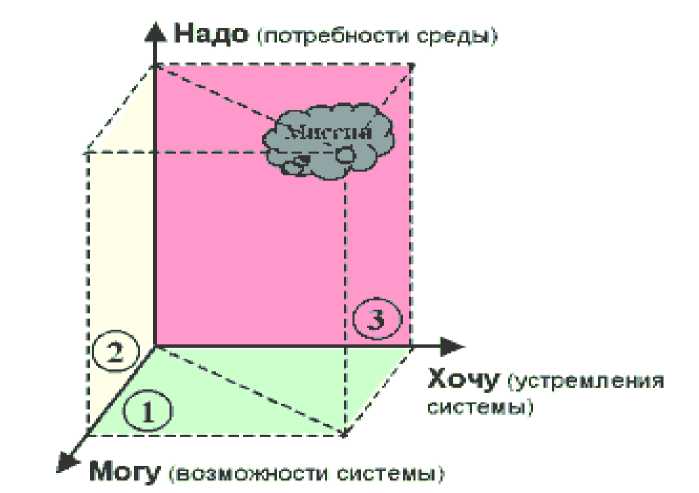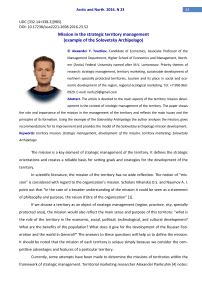Mission in the strategic territory management (example of the Solovetsky Archipelago)
Автор: Alexander Y. Tsvetkov
Журнал: Arctic and North @arctic-and-north
Рубрика: Economics, political science, society and culture
Статья в выпуске: 23, 2016 года.
Бесплатный доступ
The article is devoted to the main aspects of the territory mission development in the context of strategic management of the territory. The paper shows the role and importance of the mission in the management of the territory and reflects the main issues and the principles of its formation. Using the example of the Solovetsky Archipelago the author analyzes the mission, gives recommendations for its improvement and provides the model of the Solovetsky archipelago mission development.
Territory mission, strategic management, development of the mission, territory marketing, Solovetsky Archipelago
Короткий адрес: https://sciup.org/148318655
IDR: 148318655 | УДК: [332.14+338.2](985) | DOI: 10.17238/issn2221-2698.2016.23.52
Текст научной статьи Mission in the strategic territory management (example of the Solovetsky Archipelago)
Archipelago
The mission is a key element of strategic management of the territory. It defines the strategic orientations and creates a reliable basis for setting goals and strategies for the development of the territory.
In scientific literature, the mission of the territory has no wide reflection. The notion of “mission” is considered with regard to the organization's mission. Scholars Vihanskij O.S. and Naumov A. I. point out that “in the case of a broader understanding of the mission it could be seen as a statement of philosophy and purpose, the raison d'être of the organization” [1].
If we choose a territory as an object of strategic management (region, province, city, specially protected area), the mission would also reflect the main sense and purpose of this territory: “what is the role of the territory in the economic, social, political, technological, and cultural development? What are the benefits of the population? What does it give for the development of the Russian Federation and the world in General?” The answers to these questions will help us to define the mission. It should be noted that the mission of each territory is unique simply because we consider the competitive advantages and features of a particular territory.
Currently, some attempts have been made to determine the missions of territories within the framework of strategic management. Territorial marketing researcher Alexander Pankruhin [4] notes:
“in most cases, the mission is still confused with the slogan and brand-image, labeling them basically for an effect”, i.e. almost meaningless and useless. Therefore, at the Sochi international investment forum many Russian regions had slogans like “Ryazan is the soul of Russia”, “Gelendzhik is a city of my dreams”, etc. However, in this publication, the author’s focuse is on positive examples of defining missions: “quite another matter — the mission of the distant from the capital and from Europe, but advanced area of Yuzhno-Sakhalinsk. In a town development strategy, the islanders identified their mission quite tangibly: “formation of administrative, cultural and business Russian-Japanese Center in the Far East that works for the integration between the two countries. The city motto looks also good: “shaping new relations between Russia and Japan” [4].
Strategic management of the territory includes the following milestones: 1) defining a mission of the territory; 2) setting goals for its development; 3) formulating strategies and developing plans; 4) practise the development strategy of the territory; 5) monitoring and evaluation of its effectiveness. The implementation of each phase should be prefaced by a comprehensive integrated analysis of factors needed for the development of the territory. Thus, the definition of the mission is a determining step and it depends on the efficiency of strategic management of the territory.
The mission should reflect the specific features of the territory, its competitive advantages and the potential for development of the territory. The mission of protected areas should be directed to the preservation, study and balanced development of the unique natural, historical and cultural, spiritual resources and values of the territory in favour of the future generations with a focus on a long-term sustainable development.
The main difficulty in developing the mission is, firstly, the need for a thorough analysis of the internal and external factors, affecting the development of the territory; secondly, demanding a concise mission statement; thirdly, the compulsory separation of the mission, goals and strategies for the development of the territory. You should not mix and replace these concepts: mission defines the meaning and assignment of territories; the objectives define the desired results of its development, and indicates the direction and goals of the strategy.
Arkhangelsk Region Government Decree No. 310-RP July 16, 2013 approved the Solovetsky Archipelago development strategy as a unique object of spiritual, historical, cultural and natural heritage, and defined the mission of the Solovetsky Archipelago. According to the document: "the Mission of the Solovetsky Archipelago in the world today is to provide a revival, preservation and adequate perception of traditional values in Russian and world communities; to serve the formation of highly educated, morally-oriented, creative, socially responsible individuals. The legacy of Solovki in all its uniqueness and multi-component nature helps to keep the life orientations and values of an- cestors, a people characterized by a holistic worldview, high spiritual and moral qualities, great creative potential, tremendous resilience, high civil sense and ability to unite”1.
Next is the statement: “the Mission of the Solovetsky archipelago is also ensuring decent living conditions for the local population”2. In our opinion, this supplement increasingly refers not to the mission but to the most important strategic objectives of the development of the Solovetsky Archipelago, capable of realizing the mission. It is the capacity of the local population that should be used for the implementation of the strategy and mission of the Solovetsky Archipelago.
In the monograph “Upgrade mechanism for sustainable rural development”, published by the Russian Academy of natural sciences in 2014 [3], the importance of strategic management mechanisms in the development of the territory was highlighted and indicated that the mission was one of the central points of the development of socio-economic development strategy. According to the authors of the monograph: “the mission primary purpose characterizes the rural territories, the goal of existence for the inhabitants to the outside world, in historical terms. It is integrating rural community being an important moment of awareness of corporatism and the main objectives of its existence. At the same time, the mission is a visit card of the countryside, brochure, designed to tell the most important features of its enxistence and development” [3].
The mission may be developed in two versions: 1) full global mission statement or the primary purpose (listed above); 2) short version the mission formulated as slogan, appeal, which can be used in marketing territory. The first version of the mission should be used in strategic management, territorial development, for investors, partners and others interested in the development of the territory. The second (short) version of the mission can be used at the web page, as an element of promotion and a brief statement about the appointment. Therefore, tourists could visit the Solovetsky Archipelago web page before going there. After a short reading of the mission, they should get a sence of respect to the heritage of the Solovetsky Archipelago.
To define the mission of the territory, one should undertake a comprehensive analysis of the factors of its development, for example, using SWOT-analysis, PEST-analysis, competitive analysis and other methods. When conducting a SWOT-analysis it should not only determine the strengths, weaknesses, opportunities and threats, but also it is nedded to assess their influence, rank in order of importance or in determining the mission. Therefore, we use only the most important factors.
In case of Solovetsky Archipelago, in our opinion: the greatest strength is a unique complex spiritual, historical, cultural and natural heritage; the weakest point — the inefficiency of the system and strategic management at various levels, including the implementation of the strategic development programmes; a key feature is the improvement of strategic management and establishment of an effective system of governance by overcoming the existing contradictions between the key actors, to ensure a balanced development of the territory; and the main threat — a threat of destruction of the unique architectural and natural monuments of the Solovetsky Archipelago. Monitoring of reconstruction and exploitation of monuments done by the state and international organizations (UNESCO) should ensure the removal of the threat.
It should be noted that, while conducting a SWOT-analysis of the Solovetsky Archipelago there is no clear delineation on the internal factors of development (strengths and weaknesses) and external potential development factors (opportunities and threats) as internal and external. They are not only closely linked, but also interdependent. Thus, the strategic management of the Solovetsky Archipelago is mainly external. The Ministry of Culture of the Russian Federation, the Government of Arkhangelsk region, Russian Orthodox Church, and others do it.
Development of the mission may be carried out on the model of “need — can — want” and using the axes (fig. 1) [2].

Figure 1. How to develop a mission
The axis “need” reflects the needs of community, the axis of "can" – system capabilities, the axis “want” — aspirations of the system. We are considering these options in relation to the territory of the
Solovetsky Archipelago (tab. 1).
Table 1
|
Parameter |
Parameter |
Drillthrough setting |
|
|
"Need" |
Needs of the community |
|
THE MISSION OF THE SOLOVETSKY ARCHIPELAGO |
|
«Can» |
Opportunities Of the territory |
|
|
|
«Want» |
The goal of the territory |
The strategy of the Solovetsky archipelago identified 3 key strategic objectives [1]:
and social life of the population of the Solovetsky archipelago. |
Mission development model of the Solovetsky archipelago
In addition to the mission, specified in the Development strategy of the Solovetsky archipelago, we recommend that one also develops a summary version of the mission using the presented model. The short version of the mission could be formulated taking into account three parameters: external needs, opportunities and development of the territory itself. In determining the short version of the mission of the Solovetsky archipelago, it is necessary to reconcile the interests of the various actors: 1) the Federal and municipal authorities; 2) The Solovetsky monastery; 3) Solovki State historical, architectural and natural museum-reserve; 4) local population; 5) business community; 6) scientific community; 7) other development organizations, such as the Solovki branch of “Arhoblenergo”, Solovki forestry, etc.
The actors should develop common approaches to the strategic territory management of the Solovetsky Archipelago. One example of such an integrated approach on the Solovetsky Islands: the principle of “five keys” proposed by the Agency for the development of the Solovetsky Archipelago. The principle means close collaboration in decision-making between the regional government, Primorsky District, rural settlement Solovki, Solovetsky male monastery and Solovetsky state historical architectural and natural museum-reserve. In our view, this principle could be supplemented by compulsory harmonization of decisions with the representatives of the scientific community, business and local population.
Thus, the mission of the territory reveals the main purpose of the territory, reflects the interests, goals and capacity of key actors, who intend to implement this mission through the implementation of the objectives and development strategies.
Список литературы Mission in the strategic territory management (example of the Solovetsky Archipelago)
- Vihanskij O.S., Naumov A.I. Menedzhment. M.: Ekonomist, 2015. p. 227.
- Gorelik S. Biznes-inzhiniring i missiya kompanii. URL: http://www.interface.ru/fset.asp?Url=/misc/bizinj.htm (Accessed: 26 February 2016).
- Kovalenko E.G., Polushkina T.M., Yakimova O.Yu., Avtajkina E.V., Zajceva O.O., Sedova K.S. Modernizaciya mekhanizma ustojchivogo razvitiya selskih territorij: URL: http://www.rae.ru/ monographs/247-7384 (Accessed: 20 February 2016).
- Pankruhin A. Marketing territorij rossijskih regionov: lica, obrazy i pozicii. URL: http://mba.rea.ru/Main.aspx?page=Pankruhin_marketing_territor_rus (Accessed: 20 February 2016).


